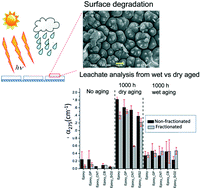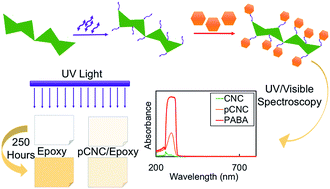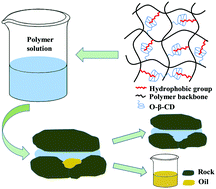Themed collection Polymers in liquid formulations

Stimuli-responsive temporary adhesives: enabling debonding on demand through strategic molecular design
Stimuli-responsive temporary adhesives emerge as next-generation multifunctional materials with advantages that include strong temporary adhesion, debonding on demand, and tunable reactivity.

Chem. Sci., 2021,12, 15183-15205
https://doi.org/10.1039/D1SC03426J
Mechanical reinforcement of granular hydrogels
The mechanical properties of granular hydrogels are strongly influenced by interparticle interactions. In this review, we compare the storage, compressive and tensile moduli of granular hydrogels cured using various interparticle interactions.

Chem. Sci., 2022,13, 3082-3093
https://doi.org/10.1039/D1SC06231J
Emerging investigator series: polymeric nanocarriers for agricultural applications: synthesis, characterization, and environmental and biological interactions
This review discusses polymeric nanocarriers for agrochemical delivery, from synthesis, characterization, and release, to benefits for agrochemical efficiency and sustainability.

Environ. Sci.: Nano, 2020,7, 37-67
https://doi.org/10.1039/C9EN01127G
The fate and impact of coagulants/flocculants in sludge treatment systems
Coagulants and flocculants have been widely used in various applications, especially in wastewater treatment and sludge dewatering, which result in their high accumulation in waste-activated sludge (WAS).

Environ. Sci.: Water Res. Technol., 2021,7, 1387-1401
https://doi.org/10.1039/D1EW00165E
Future opportunities for bio-based adhesives – advantages beyond renewability
A review pointing out and exemplifiying the advantages bio-based adhesives can bring compared to petroleum-based adhesives beyond their renewability.

Green Chem., 2019,21, 1866-1888
https://doi.org/10.1039/C8GC03746A
A highly transparent ionogel with strength enhancement ability for robust bonding in an aquatic environment
An ionogel with strength enhancement ability was developed for underwater adhesion. Taking advantage of the excellent interface adaptability and high mechanical strength of the ionogel, its underwater adhesion strength can reach 5.18 ± 0.27 MPa.

Mater. Horiz., 2021,8, 2057-2064
https://doi.org/10.1039/D1MH00461A
The transfer and amplification of cyanostilbene molecular function to advanced flexible optical paints through self-crosslinkable side-chain liquid crystal polysiloxanes
Advanced flexible optical paints are created using the maximized functionality and availability of PMHS, which allows polarized emissive and photopatternable secret coatings on a macroscopic area.

Mater. Horiz., 2021,8, 1561-1569
https://doi.org/10.1039/D1MH00004G
Effect of molecular weight and polymer composition on gallol-functionalized underwater adhesive
A gallol-functionalized polymer showed strong adhesion ability underwater. The effect of molecular weight and gallol content have been optimized resulting in the underwater adhesion strength as high as 4 MPa.

J. Mater. Chem. B, 2020,8, 6798-6801
https://doi.org/10.1039/D0TB00706D
Hydrogel networks as underwater contact adhesives for different surfaces
We have developed strong and durable hydrogel adhesives for underwater bonding.

Mater. Horiz., 2020,7, 2063-2070
https://doi.org/10.1039/D0MH00176G
A reversible underwater glue based on photo- and thermo-responsive dynamic covalent bonds
A reversible underwater glue exhibits strong and widely tunable adhesion in response to orthogonal photo- and thermal stimuli.

Mater. Horiz., 2020,7, 282-288
https://doi.org/10.1039/C9MH01148J
Algae–mussel-inspired hydrogel composite glue for underwater bonding
We demonstrate a new approach to formulate mussel-inspired underwater adhesives, without requiring chemical conjugation of adhesive functionality to polymer.

Mater. Horiz., 2019,6, 285-293
https://doi.org/10.1039/C8MH01421C
Multimodal underwater adhesion using self-assembled Dopa-bearing ABA triblock copolymer networks
Self-assembled mechanically robust Dopa-bearing triblock copolymer networks improve underwater adhesion through both energy dissipation and interfacial bonding.

J. Mater. Chem. B, 2018,6, 545-549
https://doi.org/10.1039/C7TB02371E
A dual-mode laser-textured ice-phobic slippery surface: low-voltage-powered switching transmissivity and wettability for thermal management
An electric-triggered dual-mode slippery liquid infused surface enabled by ultra-fast laser is reported for solving challenges in integrating anti-icing, self-cleaning and light-regulating functionalities into a single device.

Nanoscale, 2022,14, 4474-4483
https://doi.org/10.1039/D1NR07940A
A nanocarrier pesticide delivery system with promising benefits in the case of dinotefuran: strikingly enhanced bioactivity and reduced pesticide residue
SPc can be conjugated with dinotefuran through hydrogen bonding and van der Waals forces, which reduce particle size, increase plant uptake and bioactivity, and decrease residue. The dinotefuran/SPc complex is relatively safe to predators and plants.

Environ. Sci.: Nano, 2022,9, 988-999
https://doi.org/10.1039/D1EN00752A
UV curable stimuli-responsive coatings with antifogging and oil-repellent performances
A stimuli-responsive antifogging/oil-repellent coating with a delicate balance between hydrophilic and oleophobic components was prepared via a UV-assisted cross-linking method.

J. Mater. Chem. A, 2021,9, 26028-26035
https://doi.org/10.1039/D1TA07934D
Microaerobic conditions in anaerobic sludge promote changes in bacterial composition favouring biodegradation of polymeric siloxanes
Microaeration changes the native anaerobic microbial community composition allowing the degradation of polydimethylsiloxanes and releasing volatile siloxanes into biogas.

Environ. Sci.: Processes Impacts, 2021,23, 1182-1197
https://doi.org/10.1039/D1EM00143D
Shining a new light on the structure of polyurea/polyurethane materials
Polyurea and polyurethane are widely used in coatings, foams, and micro- and nanocapsules. Investigations of the polymers structure indicate that a significant amount of hydrolyzed isocyanate is incorporated in the macromolecular backbone.

Polym. Chem., 2021,12, 3893-3899
https://doi.org/10.1039/D1PY00649E
Coacervation-driven instant paintable underwater adhesives with tunable optical and electrochromic properties
Novel coacervation-driven instant underwater adhesive with tunable optical and electrochromic properties, driven by synergistic effects of hydrogen-bonding and hydrophobic interaction.

J. Mater. Chem. A, 2021,9, 12988-13000
https://doi.org/10.1039/D1TA01658J
A self-healing, recyclable, and degradable fire-retardant gelatin-based biogel coating for green buildings
Application of a self-healing, recyclable and fire-retardant gelatin-based biogel coating is a sustainable and eco-friendly method for the fire safety of green buildings.

Soft Matter, 2021,17, 5231-5239
https://doi.org/10.1039/D1SM00435B
Limonene-in-water Pickering emulsion and on-demand separation using thermo-responsive biodegradable nanoparticles
Modular thermo-responsive and biodegradable polymer nanoparticles enable the tuning of the properties of Pickering emulsions and the release of the emulsified fragrance on-demand.

Nanoscale, 2021,13, 8543-8554
https://doi.org/10.1039/D1NR00694K
Recyclable, reprocessable, self-adhered and repairable carbon fiber reinforced polymers using full biobased matrices from camphoric acid and epoxidized soybean oil
Recyclable carbon fiber composites were prepared using full biobased dynamic matrices from camphoric acid and epoxidized soybean oil.

Green Chem., 2021,23, 2763-2772
https://doi.org/10.1039/D1GC00648G
Synthesis and structural characterization of bio-based bis(cyclic carbonate)s for the preparation of non-isocyanate polyurethanes
Full chemical structure characterization of cyclic carbonates from diepoxides synthesized using sustainable bio-based polyols with different molecular weights and carbon dioxide.

Polym. Chem., 2021,12, 1643-1652
https://doi.org/10.1039/D0PY01576H
Synthesis and characterization of fully biobased polyesters with tunable branched architectures
A series of sugar-derived triols and biobased diacids were combined to prepare fully biobased branched polyesters with different structural features by melt polycondensation.

Polym. Chem., 2021,12, 991-1001
https://doi.org/10.1039/D0PY01512A
HMF–glycerol acetals as additives for the debonding of polyurethane adhesives
Diols prepared via acetalisation of HMF with glycerol were incorporated into polyurethanes. This additive enables the selective debonding by acid-catalysed hydrolysis of PU-based adhesives to facilitate the recycling of components at the end of life of the product.

Green Chem., 2021,23, 957-965
https://doi.org/10.1039/D0GC04093B
Smart nanocomposites of chitosan/alginate nanoparticles loaded with copper oxide as alternative nanofertilizers
A chitosan and sodium alginate complex acts as a biodegradable shell to release nanoscaled nutrients, CuO nanoparticles, as an alternative smart delivery nanofertilizer.

Environ. Sci.: Nano, 2021,8, 174-187
https://doi.org/10.1039/D0EN00797H
High performance LiMnFePO4/Li4Ti5O12 full cells by functionalized polymeric additives
Herein, we report a novel class of additives based on functional polymers for electrode fabrication applied in the first fast charge–discharge and high-voltage LiMnFePO4/Li4Ti5O12 batteries operating at 3.0 V.

Mater. Adv., 2021,2, 253-260
https://doi.org/10.1039/D0MA00679C
Stratification of polymer–colloid mixtures via fast nonequilibrium evaporation
In drying liquid films of polymer–colloid mixtures, stratification in which polymers are placed on top of larger colloids is studied.

Soft Matter, 2020,16, 10326-10333
https://doi.org/10.1039/D0SM01504K
Synthesis and antibacterial investigation of cationic waterborne polyurethane containing siloxane
Cationic waterborne polyurethane containing siloxane and quaternary ammonium salt in the side chain was synthesized, which showed an enhanced antibacterial property and hydrophobicity.

New J. Chem., 2020,44, 19759-19768
https://doi.org/10.1039/D0NJ04625F
Hydrophilic surfaces from simple dip-coating method: amphiphilic block copolymers with zwitterionic group form antifouling coatings under atmospheric conditions
Amphiphilic block copolymers with zwitterionic group form antifouling coatings under atmospheric conditions by a dip-coating method.

Mater. Adv., 2020,1, 2737-2744
https://doi.org/10.1039/D0MA00184H
Interaction between a nano-formulation of atrazine and rhizosphere bacterial communities: atrazine degradation and bacterial community alterations
Nanotechnology can potentially revolutionize the agricultural industry by offering nano-formulations of pesticides, the so-called nano-pesticides, but the adverse effects of nano-pesticides must be known in non-target organisms.

Environ. Sci.: Nano, 2020,7, 3372-3384
https://doi.org/10.1039/D0EN00638F
Self-healable transparent polymer/salt hybrid adhesive via a ternary bonding effect
A transparent self-healable hybrid adhesive with multiple functions based on a novel co-existing ternary bridging bond self-healing mechanism.

J. Mater. Chem. A, 2020,8, 21812-21823
https://doi.org/10.1039/D0TA06935C
Study on the adsorption mechanism of benzoylurea insecticides onto modified hyperbranched polysilicon materials
Several hyperbranched polysilicon with different end group modifications were prepared, and the adsorption mechanism of benzoylureas onto the obtained materials were investigated based on the density functional theory and adsorption studies.

RSC Adv., 2020,10, 28664-28673
https://doi.org/10.1039/D0RA04068A
Biosourced terpenoids for the development of sustainable acrylic pressure-sensitive adhesives via emulsion polymerisation
Terpenoid-based (meth)acrylates are introduced in waterborne acrylic pressure-sensitive adhesives via emulsion polymerization. These materials showed good tack, peel strength and shear resistance properties, comparable to a petroleum-based benchmark.

Green Chem., 2020,22, 4561-4569
https://doi.org/10.1039/D0GC01350A
Fragmentation of polymer nanocomposites: modulation by dry and wet weathering, fractionation, and nanomaterial filler
Weathering and fragmentation of polymer nanocomposites.

Environ. Sci.: Nano, 2020,7, 1742-1758
https://doi.org/10.1039/C9EN01360A
A reversible and highly conductive adhesive: towards self-healing and recyclable flexible electronics
Flexible conductive adhesives are important materials for the next generation of flexible electronic devices.

J. Mater. Chem. C, 2020,8, 7772-7785
https://doi.org/10.1039/C9TC06765E
Preparation and solution properties of polyacrylamide-based silica nanocomposites for drag reduction application
A novel nanocomposite drag reducer showed excellent drag reduction performance by improving strength and rigidity of a polymer structure.

New J. Chem., 2020,44, 9802-9812
https://doi.org/10.1039/C9NJ05583E
A zwitterionic polymer containing a hydrophobic group: enhanced rheological properties
A zwitterionic polymer containing a hydrophobic long chain, named MANPS, was independently developed by free radical solution polymerization.

New J. Chem., 2020,44, 9703-9711
https://doi.org/10.1039/D0NJ01687J
Enhancing the mechanical and thermal properties of waterborne polyurethane composites with thermoset epoxy resin microspheres
A facile way to prepare WPU with good mechanical and thermal properties by adding epoxy microspheres.

New J. Chem., 2020,44, 9896-9902
https://doi.org/10.1039/D0NJ00143K
The synthesis of polymeric dyes based on waterborne polyurethane: a reaction kinetics study using UV absorption spectroscopy
The preparation of waterborne polyurethane based polymeric dyes (DWPU) with anthraquinone chromophores was monitored by using UV absorption spectroscopy for the first time.

New J. Chem., 2020,44, 2930-2940
https://doi.org/10.1039/C9NJ05490A
Preparation and characterization of soybean oil-based waterborne polyurethane/acrylate hybrid emulsions for self-matting coatings
This work aims to explore the feasibility of self-matting coatings based on soybean oil.

New J. Chem., 2019,43, 19193-19199
https://doi.org/10.1039/C9NJ04538D
Liquid amphiphilic polymer for effective airborne dust suppression
Biocompatible liquid amphiphilic polymers significantly reduce airborne dust emissions by prolonging moist conditions at dust sources and enhancing interactions between dust particles.

RSC Adv., 2019,9, 40146-40151
https://doi.org/10.1039/C9RA06787F
A novel dual-layer approach towards omniphobic polyurethane coatings
Omniphobic surfaces have a plethora of applications ranging from household paints to sensors.

RSC Adv., 2019,9, 26703-26711
https://doi.org/10.1039/C9RA04923A
Tailored cellulose nanocrystals as a functional ultraviolet absorbing nanofiller of epoxy polymers
Epoxy composites filled with UV filter decorated CNCs displayed remarkable structural stability and less discoloration under UV exposure.

Nanoscale Adv., 2019,1, 2612-2623
https://doi.org/10.1039/C9NA00265K
Boron nitride nanosheet embedded bio-inspired wet adhesives with switchable adhesion and oxidation resistance
An insulated and bactericidal mussel-mimetic nanocomposite adhesive exhibited switchable adhesion and oxidation resistance.

J. Mater. Chem. A, 2019,7, 12266-12275
https://doi.org/10.1039/C9TA02827G
Modified acrylamide copolymers based on β-cyclodextrin and twin-tail structures for enhanced oil recovery through host–guest interactions
Two kinds of copolymers with host–guest interaction were synthesized, showing great potential for enhanced oil recovery.

New J. Chem., 2019,43, 5363-5373
https://doi.org/10.1039/C8NJ06432F
About this collection
The RSC’s latest report on Polymers in Liquid Formulations (PLFs) details the important role that chemical-science research will play in developing solutions towards this global sustainability challenge in industry.
PLFs are widely used in adhesives and sealants, agrochemicals, household cleaning, inks, lubricants, paints & coatings, personal care & cosmetics and water treatment. Despite their importance, the way that PLFs are made, used and disposed of is putting unnecessary strain on the environment and creating risks for all parts of the supply chain. This collection showcases some of the innovative research on sustainability aspects of PLFs published across RSC journals.